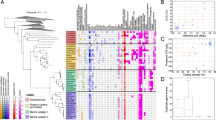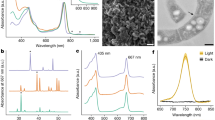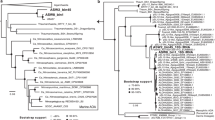Abstract
Recent advances in phylogenomic analyses and increased genomic sampling of uncultured prokaryotic lineages have brought compelling evidence in support of the emergence of eukaryotes from within the archaeal domain of life (eocyte hypothesis)1,2. The discovery of Asgardarchaeota and its supposed position at the base of the eukaryotic tree of life3,4 provided cues about the long-awaited identity of the eocytic lineage from which the nucleated cells (Eukaryota) emerged. While it is apparent that Asgardarchaeota encode a plethora of eukaryotic-specific proteins (the highest number identified yet in prokaryotes)5, the lack of genomic information and metabolic characterization has precluded inferences about their lifestyles and the metabolic landscape that favoured the emergence of the protoeukaryote ancestor. Here, we use advanced phylogenetic analyses for inferring the deep ancestry of eukaryotes, and genome-scale metabolic reconstructions for shedding light on the metabolic milieu of Asgardarchaeota. In doing so, we: (1) show that Heimdallarchaeia (the closest eocytic lineage to eukaryotes to date) are likely to have a microoxic niche, based on their genomic potential, with aerobic metabolic pathways that are unique among Archaea (that is, the kynurenine pathway); (2) provide evidence of mixotrophy within Asgardarchaeota; and (3) describe a previously unknown family of rhodopsins encoded within the recovered genomes.
This is a preview of subscription content, access via your institution
Access options
Access Nature and 54 other Nature Portfolio journals
Get Nature+, our best-value online-access subscription
$29.99 / 30 days
cancel any time
Subscribe to this journal
Receive 12 digital issues and online access to articles
$119.00 per year
only $9.92 per issue
Buy this article
- Purchase on Springer Link
- Instant access to full article PDF
Prices may be subject to local taxes which are calculated during checkout




Similar content being viewed by others
Data availability
Sequence data generated during this study have been deposited in the NCBI Sequence Read Archive (SRA) under study number SRP155597 and linked to BioProject ID PRJNA483005. The Whole Genome Shotgun project containing genome bins assembled in this study has been deposited at DDBJ/ENA/GenBank under the accessions SDMS00000000–SDOA00000000. The versions described in this paper are version SDMS01000000–SDOA01000000. The derived data that support the findings of this paper are available in figshare with the identifier https://doi.org/10.6084/m9.figshare.702262. All other relevant data supporting the findings of this study are available within the paper and its supplementary information files. No custom code that is central to the conclusions of this study was generated. All programs used in data analyses are listed in detail with their version numbers in the Nature Research Reporting Summary linked to this article.
References
Cox, C. J., Foster, P. G., Hirt, R. P., Harris, S. R. & Embley, T. M. The archaebacterial origin of eukaryotes. Proc. Natl Acad. Sci. USA 105, 20356–20361 (2008).
Williams, T. A., Foster, P. G., Cox, C. J. & Embley, T. M. An archaeal origin of eukaryotes supports only two primary domains of life. Nature 504, 231–236 (2013).
Spang, A. et al. Complex archaea that bridge the gap between prokaryotes and eukaryotes. Nature 521, 173–179 (2015).
Spang, A. et al. Asgard archaea are the closest prokaryotic relatives of eukaryotes. PLoS Genet. 14, e1007080 (2018).
Zaremba-Niedzwiedzka, K. et al. Asgard archaea illuminate the origin of eukaryotic cellular complexity. Nature 541, 353–358 (2017).
McInerney, J. O., O’Connell, M. J. & Pisani, D. The hybrid nature of the Eukaryota and a consilient view of life on Earth. Nat. Rev. Microbiol. 12, 449–455 (2014).
Da Cunha, V., Gaia, M., Nasir, A. & Forterre, P. Asgard archaea do not close the debate about the universal tree of life topology. PLoS Genet. 14, e1007215 (2018).
de Duve, C. The origin of eukaryotes: a reappraisal. Nat. Rev. Genet. 8, 395–403 (2007).
Lake, J. A., Henderson, E., Oakes, M. & Clark, M. W. Eocytes: a new ribosome structure indicates a kingdom with a close relationship to eukaryotes. Proc. Natl Acad. Sci. USA 81, 3786–3790 (1984).
Woese, C. R., Kandler, O. & Wheelis, M. L. Towards a natural system of organisms: proposal for the domains Archaea, Bacteria, and Eucarya. Proc. Natl Acad. Sci. USA 87, 4576–4579 (1990).
Eme, L., Spang, A., Lombard, J., Stairs, C. W. & Ettema, T. J. G. Archaea and the origin of eukaryotes. Nat. Rev. Microbiol. 15, 711–723 (2017).
Martijn, J., Vosseberg, J., Guy, L., Offre, P. & Ettema, T. J. G. Deep mitochondrial origin outside the sampled alphaproteobacteria. Nature 557, 101–105 (2018).
Susko, E. & Roger, A. J. On reduced amino acid alphabets for phylogenetic inference. Mol. Biol. Evol. 24, 2139–2150 (2007).
Liu, Y. et al. Comparative genomic inference suggests mixotrophic lifestyle for Thorarchaeota. ISME J. 12, 1021–1031 (2018).
Dodding, M. P. Folliculin—a tumor suppressor at the intersection of metabolic signaling and membrane traffic. Small GTPases 8, 100–105 (2017).
Pushkarev, A. et al. A distinct abundant group of microbial rhodopsins discovered using functional metagenomics. Nature 558, 595–599 (2018).
Flores-Uribe, J. Heliorhodopsins are absent in diderm (Gram-negative) bacteria: Some thoughts and possible implications for activity. Environ. Microbiol. Rep. https://doi.org/10.1111/1758-2229.12730 (2019).
Petrovskaya, L. E. et al. Predicted bacteriorhodopsin from Exiguobacterium sibiricum is a functional proton pump. FEBS Lett. 584, 4193–4196 (2010).
Alexe, M. Studiul Lacurilor Sărate din Depresiunea Transilvaniei (Presa Universitară Clujeană, Cluj-Napoca, 2010).
Sousa, F. L., Neukirchen, S., Allen, J. F., Lane, N. & Martin, W. F. Lokiarchaeon is hydrogen dependent. Nat. Microbiol. 1, 16034 (2016).
Ternes, C. M. & Schönknecht, G. Gene transfers shaped the evolution of de novo NAD+ biosynthesis in eukaryotes. Genome Biol. Evol. 6, 2335–2349 (2014).
Gazzaniga, F., Stebbins, R., Chang, S. Z., McPeek, M. A. & Brenner, C. Microbial NAD metabolism: lessons from comparative genomics. Microbiol. Mol. Biol. Rev. 73, 529–541 (2009).
Kurnasov, O. et al. Aerobic tryptophan degradation pathway in bacteria: novel kynurenine formamidase. FEMS Microbiol. Lett. 227, 219–227 (2003).
Abaibou, H., Pommier, J., Benoit, S., Giordano, G. & Mandrand-Berthelot, M. A. Expression and characterization of the Escherichia coli fdo locus and a possible physiological role for aerobic formate dehydrogenase. J. Bacteriol. 177, 7141–7149 (1995).
Brasen, C., Esser, D., Rauch, B. & Siebers, B. Carbohydrate metabolism in Archaea: current insights into unusual enzymes and pathways and their regulation. Microbiol. Mol. Biol. Rev. 78, 89–175 (2014).
Dorr, C., Zaparty, M., Tjaden, B., Brinkmann, H. & Siebers, B. The hexokinase of the hyperthermophile Thermoproteus tenax. ATP-dependent hexokinases and ADP-dependent glucokinases, two alternatives for glucose phosphorylation in Archaea. J. Biol. Chem. 278, 18744–18753 (2003).
Kono, T. et al. A RuBisCO-mediated carbon metabolic pathway in methanogenic archaea. Nat. Commun. 8, 14007 (2017).
Techtmann, S. M. et al. Evidence for horizontal gene transfer of anaerobic carbon monoxide dehydrogenases. Front. Microbiol. 3, 132 (2012).
Martin, W. F. Hydrogen, metals, bifurcating electrons, and proton gradients: The early evolution of biological energy conservation. FEBS Lett. 586, 485–493 (2012).
Betts, H. et al. Integrated genomic and fossil evidence illuminates life’s early evolution and eukaryote origins. Nat. Ecol. Evol. 2, 1556–1562 (2018).
Gastescu, P. & Teodorescu, D. C. The lakes of the Romanian Black Sea coast. man-induced changes, water regime, present state. Rom. J. Geogr. 60, 27–42 (2016).
Fedorov, P. V. Postglacial transgression of the Black Sea. Int. Geol. Rev. 14, 160–164 (1972).
Bushnell, B., Rood, J. & Singer, E. BBMerge—accurate paired shotgun read merging via overlap. PLoS ONE 12, e0185056 (2017).
Bushnell, B. BBMap short read aligner, and other bioinformatic tools. SourceForge https://sourceforge.net/projects/bbmap (2016).
Edgar, R. C. Search and clustering orders of magnitude faster than BLAST. Bioinformatics 26, 2460–2461 (2010).
Pruesse, E. et al. SILVA: a comprehensive online resource for quality checked and aligned ribosomal RNA sequence data compatible with ARB. Nucleic Acids Res. 35, 7188–7196 (2007).
Nawrocki, E. P. Structural RNA Homology Search and Alignment using Covariance Models. PhD thesis, Washington Univ. School of Medicine (2009).
Altschul, S. F., Gish, W., Miller, W., Myers, E. W. & Lipman, D. J. Basic local alignment search tool. J. Mol. Biol. 215, 403–410 (1990).
Li, D., Liu, C.-M., Luo, R., Sadakane, K. & Lam, T.-W. MEGAHIT: an ultra-fast single-node solution for large and complex metagenomics assembly via succinct de Bruijn graph. Bioinformatics 31, 1674–1676 (2015).
Hyatt, D., LoCascio, P. F., Hauser, L. J. & Uberbacher, E. C. Gene and translation initiation site prediction in metagenomic sequences. Bioinformatics 28, 2223–2230 (2012).
Steinegger, M. & Söding, J. MMseqs2 enables sensitive protein sequence searching for the analysis of massive data sets. Nat. Biotechnol. 35, 1026 (2017).
Kang, D. D., Froula, J., Egan, R. & Wang, Z. MetaBAT, an efficient tool for accurately reconstructing single genomes from complex microbial communities. PeerJ 3, e1165 (2015).
Parks, D. H., Imelfort, M., Skennerton, C. T., Hugenholtz, P. & Tyson, G. W. CheckM: assessing the quality of microbial genomes recovered from isolates, single cells, and metagenomes. Genome Res. 25, 1043–1055 (2015).
Seemann, T. Prokka: rapid prokaryotic genome annotation. Bioinformatics 30, 2068–2069 (2014).
Kanehisa, M., Sato, Y. & Morishima, K. BlastKOALA and GhostKOALA: KEGG tools for functional characterization of genome and metagenome sequences. J. Mol. Biol. 428, 726–731 (2016).
Lowe, T. M. & Eddy, S. R. tRNAscan-SE: a program for improved detection of transfer RNA genes in genomic sequence. Nucleic Acids Res. 25, 955–964 (1997).
Makarova, K. S., . & Wolf, Y. I. & Koonin, E. V. Archaeal clusters of orthologous genes (arcogs): an update and application for analysis of shared features between thermococcales, methanococcales, and methanobacteriales. Life 5, 818–840 (2015).
Jones, P. et al. InterProScan 5: genome-scale protein function classification. Bioinformatics 30, 1236–1240 (2014).
Finn, R. D. et al. HMMER web server: 2015 update. Nucleic Acids Res. 43, W30–W38 (2015).
Kelley, L. A., Mezulis, S., Yates, C. M., Wass, M. N. & Sternberg, M. J. E. The Phyre2 web portal for protein modeling, prediction and analysis. Nat. Protoc. 10, 845–858 (2015).
Käll, L., Krogh, A. & Sonnhammer, E. L. L. Advantages of combined transmembrane topology and signal peptide prediction—the Phobius web server. Nucleic Acids Res. 35, W429–W432 (2007).
Loytynoja, A. Phylogeny-aware alignment with PRANK. Methods Mol. Biol. 1079, 155–170 (2014).
Criscuolo, A. & Gribaldo, S. BMGE (Block Mapping and Gathering with Entropy): a new software for selection of phylogenetic informative regions from multiple sequence alignments. BMC Evol. Biol. 10, 210 (2010).
Hoang, D. T., Chernomor, O., von Haeseler, A., Minh, B. Q. & Vinh, L. S. UFBoot2: Improving the Ultrafast Bootstrap Approximation. Mol. Biol. Evol. 35, 518–522 (2018).
Nguyen, L.-T., Schmidt, H. A., von Haeseler, A. & Minh, B. Q. IQ-TREE: a fast and effective stochastic algorithm for estimating maximum-likelihood phylogenies. Mol. Biol. Evol. 32, 268–274 (2015).
Lartillot, N., Rodrigue, N., Stubbs, D. & Richer, J. PhyloBayes MPI: phylogenetic reconstruction with infinite mixtures of profiles in a parallel environment. Syst. Biol. 62, 611–615 (2013).
Notredame, C., Higgins, D. G. & Heringa, J. T-Coffee: A novel method for fast and accurate multiple sequence alignment. J. Mol. Biol. 302, 205–217 (2000).
Edgar, R. C. MUSCLE: multiple sequence alignment with high accuracy and high throughput. Nucleic Acids Res. 32, 1792–1797 (2004).
Tabita, F. R. et al. Function, structure, and evolution of the RubisCO-like proteins and their RubisCO homologs. Microbiol. Mol. Biol. Rev. 71, 576–599 (2007).
Wrighton, K. C. et al. RubisCO of a nucleoside pathway known from Archaea is found in diverse uncultivated phyla in bacteria. ISME J. 10, 2702–2714 (2016).
Castro-Fernandez, V. et al. Reconstructed ancestral enzymes reveal that negative selection drove the evolution of substrate specificity in ADP-dependent kinases. J. Biol. Chem. 292, 21218 (2017).
Katoh, K. MAFFT: a novel method for rapid multiple sequence alignment based on fast Fourier transform. Nucleic Acids Res. 30, 3059–3066 (2002).
Price, M. N., Dehal, P. S. & Arkin, A. P. FastTree 2—approximately maximum-likelihood trees for large alignments. PLoS ONE 5, e9490 (2010).
Acknowledgements
We thank Z. Keresztes, V. Muntean, T. Szőke-Nagy, M. Alexe, A. Cristea and A. Baricz for their technical support during sampling and sample preparation, and E. A. Levei and M. Șenilă for contributions to chemical analyses. P.-A.B was supported by the research grant PN-III-P4-ID-PCE-2016-0303 (Romanian National Authority for Scientific Research). H.L.B. was supported by the research grants PN-III-P4-ID-PCE-2016-0303 (Romanian National Authority for Scientific Research) and STAR-UBB Advanced Fellowship-Intern (Babeș-Bolyai University). A.-Ş.A. was supported by the research grants: 17-04828 S (Grant Agency of the Czech Republic) and MSM200961801 (Academy of Sciences of the Czech Republic). M.M. was supported by the Postdoctoral Programme PPPLZ L200961651 (Academy of Sciences of the Czech Republic). R.G. was supported by the research grant 17-04828 S (Grant Agency of the Czech Republic).
Author information
Authors and Affiliations
Contributions
H.L.B. and P.-A.B. designed the study. P.-A.B., A.-Ş.A. and R.G. wrote the manuscript. P.-A.B., A.-Ş.A., R.G., M.M.S. and M.M. analysed and interpreted the data. R.G., O.B., K.I. and H.K. performed rhodopsin data analyses. All authors commented on and approved the manuscript.
Corresponding author
Ethics declarations
Competing interests
The authors declare no competing interests.
Additional information
Publisher’s note: Springer Nature remains neutral with regard to jurisdictional claims in published maps and institutional affiliations.
Supplementary Information
Supplementary Information
Supplementary Discussion, Supplementary Figures 1–7, Supplementary Table 2, Supplementary Table 5, Supplementary Tables 7–9 and Supplementary References.
Supplementary Table 1
General statistics for MAGs recovered from the Amara and Tekirghiol Lakes.
Supplementary Table 3
KEGG orthology annotation for Asgardarchaeota MAGs.
Supplementary Table 4
Taxonomy and gene function assignment for Heimdall_RS678-c45 contig by blastx (default parameters).
Supplementary Table 6
Lineages used for inferring phylogenies.
Rights and permissions
About this article
Cite this article
Bulzu, PA., Andrei, AŞ., Salcher, M.M. et al. Casting light on Asgardarchaeota metabolism in a sunlit microoxic niche. Nat Microbiol 4, 1129–1137 (2019). https://doi.org/10.1038/s41564-019-0404-y
Received:
Accepted:
Published:
Issue Date:
DOI: https://doi.org/10.1038/s41564-019-0404-y
This article is cited by
-
BASALT refines binning from metagenomic data and increases resolution of genome-resolved metagenomic analysis
Nature Communications (2024)
-
Actin cytoskeleton and complex cell architecture in an Asgard archaeon
Nature (2023)
-
Trait biases in microbial reference genomes
Scientific Data (2023)
-
Inference and reconstruction of the heimdallarchaeial ancestry of eukaryotes
Nature (2023)
-
Unique mobile elements and scalable gene flow at the prokaryote–eukaryote boundary revealed by circularized Asgard archaea genomes
Nature Microbiology (2022)



